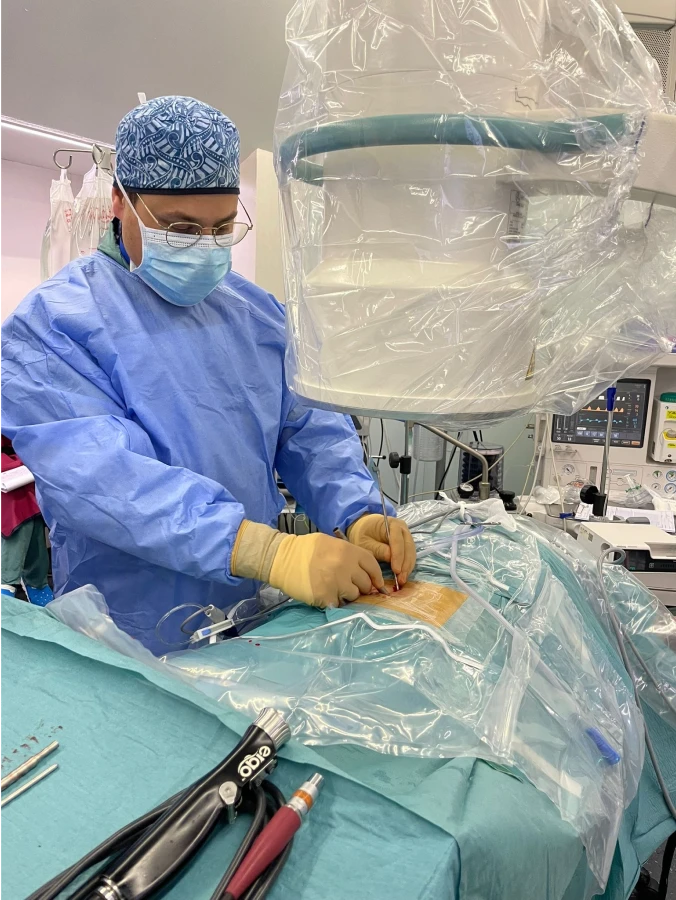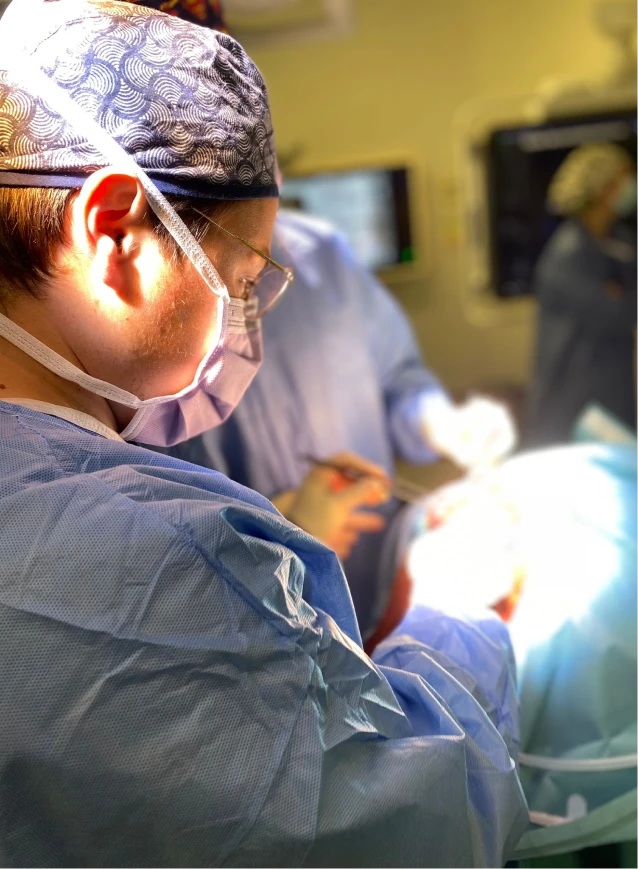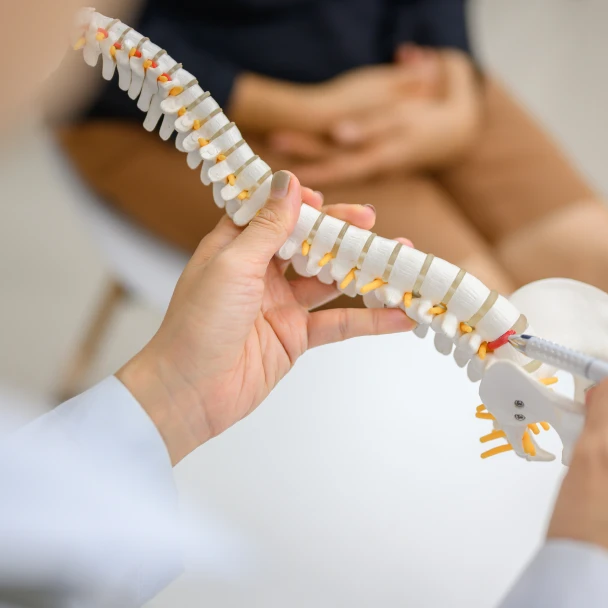It is a minimally invasive technique that allows decompression of nerves or complex spinal interventions. After surgery, most patients are discharged within a few hours, with almost no pain, and can resume normal life within a few weeks, including sports practice in the case of athletes.
In addition, in older people, the surgical risk is reduced, allowing this technique to be performed in those who cannot undergo classic surgery.
More information
When is endoscopic spine surgery necessary?
In our practice, we prioritize a personalized approach, designing a therapeutic plan tailored to each patient based on the severity of symptoms, the specific condition and its impact on your quality of life.
Treatments according to the situation
Early stages or mild pain
For cases of tolerable pain or early stage symptoms, we recommend regenerative therapies. These minimally invasive techniques help reduce pain and stimulate the natural recovery of tissues, allowing in many cases to avoid or delay the need for surgery.
Severe pain or significant nerve damage
When pain becomes disabling or there is major nerve damage, endoscopic spine surgery is an effective and minimally invasive solution. This procedure relieves pressure on the nerves, restores spinal function and significantly improves the patient’s quality of life.
A comprehensive and specialized approach
Each patient is unique. Therefore, we carefully evaluate your case through advanced imaging studies and a detailed diagnosis to determine the best therapeutic option. Our goal is to offer effective treatments with the least possible invasiveness, always prioritizing your well-being and recovery.

Advantages of an innovative technique
Less invasive: Significantly reduces damage to muscle and surrounding tissues compared to traditional surgical techniques.
Faster recovery: As a less invasive procedure, patients experience shorter recovery times, allowing them to resume their daily activities sooner.
Less postoperative pain: Discomfort after surgery is minimal due to the precise and delicate approach of this technique.
Reduced risks: Small incisions reduce the risk of infections, complications and visible scars.
High precision: The endoscopic camera provides a detailed view of the affected area, allowing the surgeon to act with great accuracy.
Shorter hospitalization: In many cases, surgery is performed on an outpatient basis, which means that the patient can return home the same day.

Recovery after Endoscopic Spine Surgery
What is the recovery process like?
- Short or outpatient hospitalization: In most cases, surgery is performed on an outpatient basis, allowing the patient to return home the same day or after a short stay in the hospital.
- Minimal discomfort: As a less invasive procedure, patients usually experience less postoperative pain, which can be controlled with mild analgesics.
- Gradual return to activities: Light activities, such as walking, can be resumed in a few days.
Depending on the nature of the job, it is possible to return to work activities in one to two weeks.
Sports or more intense physical activities usually require 4 to 6 weeks. - Personalized physical therapy: In some cases, rehabilitation therapy is recommended to strengthen the back muscles and improve mobility.
Dr. Sanmillan and his team will be with you at every stage of the recovery process, giving you personalized guidance and making sure you get the best possible results.
If you have questions about recovery or want to know how to prepare for surgery, schedule a consultation with Dr. Sanmillan and take the first step toward a healthy, pain-free spine.

Related pathologies
Other specialties
Regenerative therapy
Minimally invasive open surgery
Preguntas frecuentes
-
La endoscopia de columna es una técnica quirúrgica mínimamente invasiva que utiliza una cámara endoscópica para tratar problemas de la columna vertebral. A diferencia de la operación de columna lumbar clásica, no requiere grandes incisiones, además de reducir el daño a músculos y tejidos, por lo tanto se acorta la recuperación y disminuye el dolor postoperatorio.
-
La endoscopia de columna se recomienda cuando existen afecciones en la columna que causan dolores intensos o daño nervioso significativo y que no responden a tratamientos conservadores. Esto se da más frecuentemente en casos de hernias discales, estenosis de canal o compresiones nerviosas de otra índole que afectan la movilidad y la calidad de vida del paciente.
-
La recuperación después de una endoscopia de columna suele ser mucho más rápida que en una cirugía convencional. En la mayoría de los casos:
- El paciente vuelve a casa el mismo día o tras una breve hospitalización de 8 a 12h.
- Puede caminar y realizar actividades ligeras en pocos días.
- El retorno laboral es posible entre 1 y 2 semanas, según el tipo de trabajo.
- Los deportes o actividades físicas intensas requieren entre 4 y 6 semanas.
-
En algunos pacientes, tras una operación de columna lumbar endoscópica, el especialista recomienda un plan de fisioterapia personalizado. Este ayuda a fortalecer los músculos de la espalda, mejorar la movilidad y acelerar el proceso de rehabilitación para asegurar resultados duraderos. incluso en casos seleccionados se confecciona un plan conjunto con el fisioterapeuta que incluye fisioterapia antes de la cirugía para favorecer ir al quirófano en las mejores condiciones y favorecer la recuperación posterior.
-
Sí. Al ser una técnica mínimamente invasiva, la endoscopia de columna reduce el riesgo quirúrgico en personas mayores y puede aplicarse incluso en pacientes que no son candidatos a una cirugía abierta tradicional.
-
Entre los principales beneficios de la endoscopia de columna destacan:
- Menor invasión quirúrgica y cicatrices mínimas.
- Dolor postoperatorio reducido.
- Recuperación más rápida y hospitalización breve.
- Menores riesgos de infección o otras complicaciones.
- Alta precisión gracias a la visión proporcionada por la cámara endoscópica.


